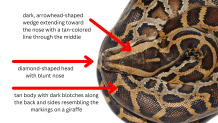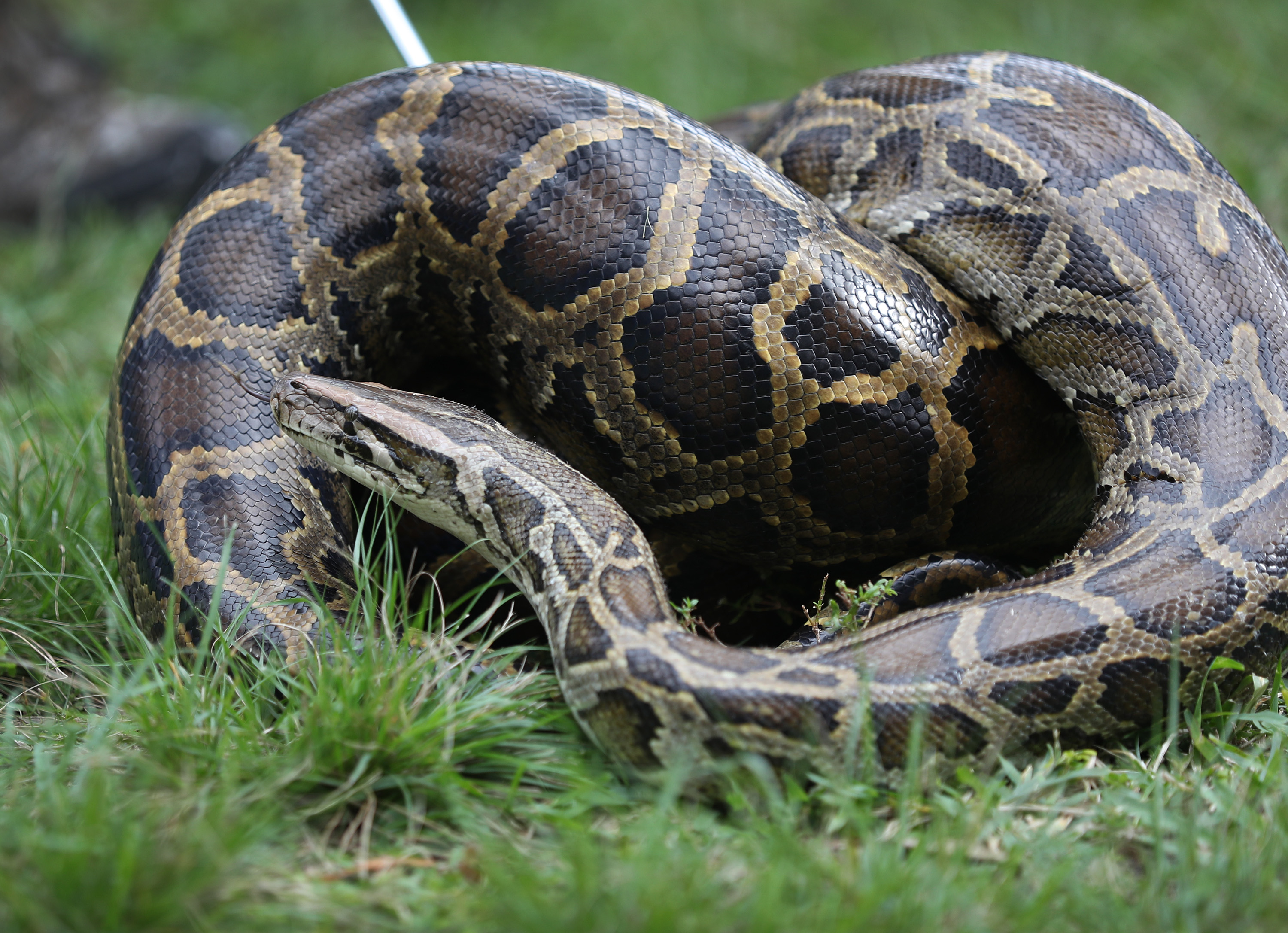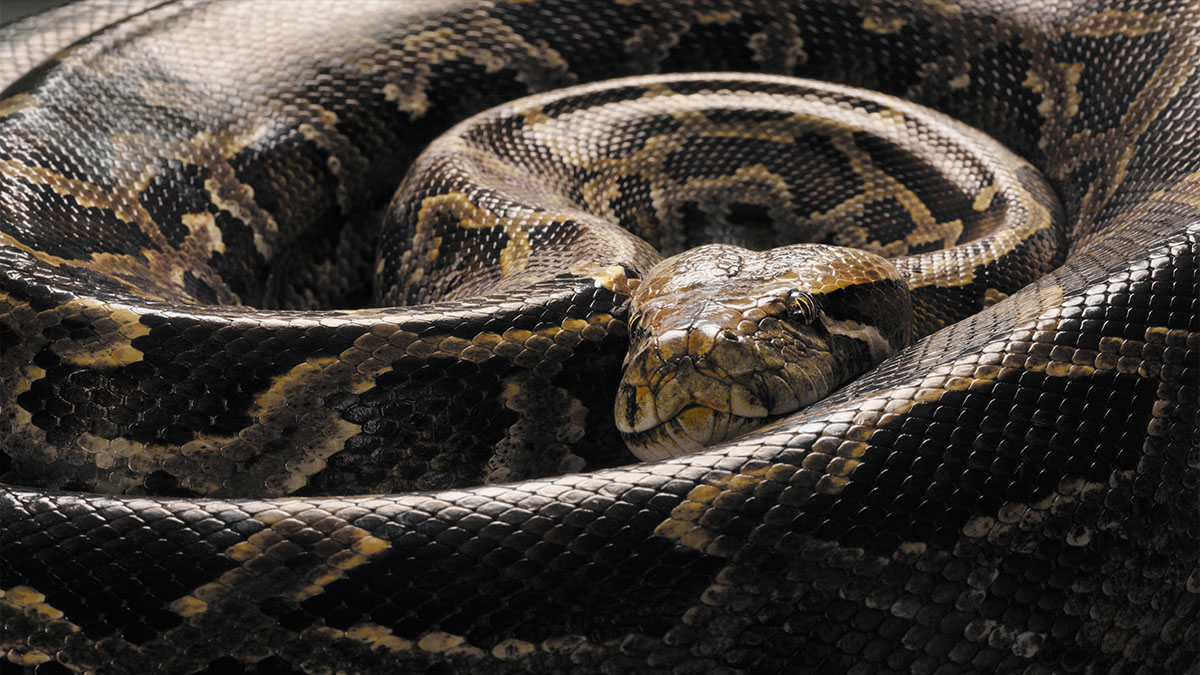It's a danger to our ecosystem that Floridians know all too well.
The Burmese python is best known in South Florida for destroying the Everglades — but what makes them such a threat?
Because these pythons are one of the state's most notorious invasive species, the Florida Fish and Wildlife Commission has implemented several efforts to remove the large nonvenomous constrictors from our ecosystem — primarily by humanely killing them.
But why do Burmese pythons need to be removed from the state, and what makes them such a danger to our environment?
Get South Florida local news, weather forecasts and entertainment stories to your inbox. Sign up for NBC South Florida newsletters.
Here's everything you need to know about the slithery invaders:
How can you tell a Burmese python apart from other snakes?
An easy way to tell Burmese pythons apart from other snakes is by their size alone, according to McKayla Spencer, the FWC's Nonnative Fish and Wildlife Program Coordinator.
Adult pythons caught in Florida average between six and nine feet long, but Spencer says it's not uncommon to find pythons much longer than that.
"The largest any of the native snakes in the United States get are below 10 feet," said Spencer. "And we are regularly pulling pythons out of the Everglades that are over 10 feet long."
Just as recently as July, a Florida hunter caught the longest Burmese python the state has ever seen.
At 19 feet and 125 pounds, the female snake is said to be the longest of its species to have ever been recorded, according to the Conservancy of Southwest Florida.
Another way to identify a Burmese python is by its unique markings.

Burmese pythons are tan in color with dark blotches along the back and sides. The FWC describes the blotches as resembling puzzle pieces or the markings on a giraffe.
These pythons also have a pyramid or diamond-shaped head with a blunt nose.
The top of the head is marked by a dark, arrowhead-shaped wedge extending toward the nose with a tan-colored line through the middle.
Where are Burmese pythons found?
In South Florida, Burmese pythons are found primarily in and around the Everglades ecosystem, where the snake represents a major threat to native wildlife.
Natively, however, these pythons are found in India, lower China, the Malay Peninsula and some islands of the East Indies.
Because Burmese pythons are semi-aquatic, they are also often found near or in water.
"They're moving across that landscape with ease," said Spencer. "Whereas in humans, we’re terrestrial, so it makes it a lot more difficult for us to get out to these locations where a lot of these pythons are breeding."
What do Burmese pythons eat?
Burmese pythons are what scientists call "generalist predators," meaning that they feed on a wide variety of species.
"That means they’re not picky," says Spencer. "They're eating our native mammals and birds and reptiles, which are obviously causing vast negative impacts in our Everglades ecosystem."
By preying upon native species, invasive Burmese pythons are creating a "trophic cascade" in the Everglades.
A trophic cascade is an ecological phenomenon triggered by the addition (or removal) of a top predator — in this case, the Burmese python.
It refers to the changes in the populations of predator and prey through the food chain, which often results in dramatic changes in the ecosystem.
While pythons sometimes eat non-native species such as Norway rats, they also consume common native species, as well as threatened or endangered native species.
For instance, pythons have been known to feast on the federally threatened wood stork and the federally endangered Key Largo wood rats.
They have even been known to eat alligators, which are also federally protected by the Endangered Species Act.
"We imagine based on other systems where we've seen something similar, that when you essentially hit one level of a trophic cascade as hard as the Burmese pythons have — especially in regards to mammals — there's likely other cascading effects happening," said Spencer.
Research is currently underway to determine the impacts pythons have on native mammal species, according to the FWC.
Burmese pythons can also pose a threat to human safety and may prey upon pets such as cats and dogs.
Do Burmese pythons have any natural predators in the wild?
Because of their large size, adult Burmese pythons have few predators, with humans being an exception.
Spencer says that Burmese pythons have a higher mortality rate when they are young and small. They come out of the egg at approximately two feet long.
Because this is still within the size class of many native species of snakes, Spencer says there are some animals that will prey upon them when they're that young.
However, there is no evidence of a predator that is regularly preying upon a full-grown Burmese python, which Spencer says "isn't much of a surprise" considering how big they are.
"There's just nothing like that in the U.S.," she said.
Even so, earlier this year, a wild video posted to social media showed an alligator chowing down on a massive python in the Everglades.
BURMESE PYTHONS
How did Burmese pythons arrive in Florida?
Pythons arrived in Florida through the captive animal trade, and they were introduced through the accidental and/or purposeful release of these captive animals.
"1979 is when we had our first actual python data point," said Spencer. "And in the 1990s is when we really started to see an uptick. That's when I think people started to realize there was a problem."
At this point, most experts consider pythons to be established in Florida from the southern tip of Lake Okeechobee to the northern part of the Keys.
"Some of that is because these animals are so hard to detect," said Spencer. "By the time we're detecting them, there's a high likelihood that there's more than the single individual we're detecting."
Why are Burmese pythons difficult to detect?
Like many of Florida's native snake species, Burmese pythons are semi-aquatic.
However, Burmese pythons being semi-aquatic is a problem because it makes them harder for humans to remove.
With South Florida being a mostly semi-aquatic ecosystem, pythons can move across the landscape much easier than humans, because humans are terrestrial.
That limits our ability to get out to the locations where a lot of pythons are breeding.
Additionally, one of their main defenses is to camouflage. When these snakes try to hide themselves, they become very difficult to detect.
"You will be standing next to what you know is a 14, 15-foot python and you can't see it," said Spencer.
What are the laws surrounding Burmese python removal?
There is an ethical and legal obligation to ensure nonnative reptiles, such as Burmese pythons, are killed in a humane manner.
Nonnative reptiles are not protected in Florida except by the anti-cruelty law, which applies to all living animals in the state.
"They are terrible for the environment," said Spencer. "We have got to be removing them. But, there are safe ways to capture them and there are humane ways to kill them."
How are Burmese pythons removed?
"At this point, we're removing over 2,000 to 4,000 pythons a year," said Spencer. "There's not a lot of options on what to do when you're removing that many animals."
Because Burmese pythons are wild snakes, they behave like wild animals would. This makes them difficult — and dangerous — to remove.
"When you go to capture a wild animal, they're going to defend themselves," Spencer said. "They're going to strike, they're going to try to get away from you, they constrict, they musk."
The FWC works with partners to manage Burmese pythons in a variety of ways. Once these pythons are found, the primary method of removal is humane killing.
The American Veterinary Medical Association (AVMA) recommends a two-step process to prevent suffering and destroy the brain completely for humane killing of reptiles.
The first step should result in the animal losing consciousness immediately.
The second step, which immediately follows the first, should destroy the animal's brain by doing something called “pithing,” which prevents the animal from regaining consciousness.
"It's a very serious issue, and it's something that we want people taking seriously so that they understand the gravity of: you need to do this correctly and this is why," said Spencer.



